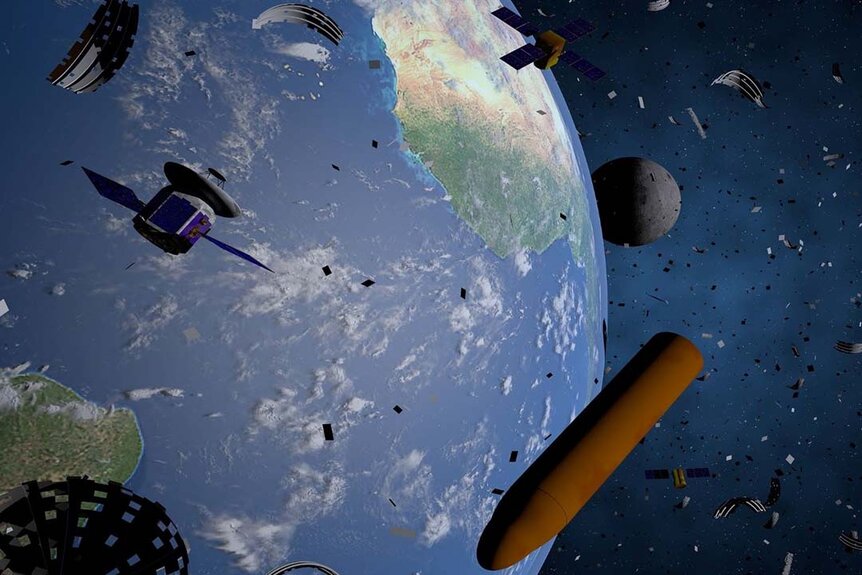Create a free profile to get unlimited access to exclusive videos, sweepstakes, and more!
A Real Life Tractor Beam for Cleaning Up Space Junk
We're here for all of the sci-fi solutions!
In 1999, astronaut John Crichton (Ben Browder) strapped into the experimental spacecraft Farscape-1 and blasted into orbit. His intended mission, to carry out a high-velocity slingshot maneuver around the planet, was cut short when Crichton fell into a wormhole and emerged in the Uncharted Territories in a distant region of the galaxy.
Finding a wide array of sentient aliens with advanced space travel technologies, Crichton makes some understandable assumptions about the tools at his disposal. In the fourth episode of Farscape (streaming now on Peacock!), “Throne for a Loss,” Crichton asks the pilot to use a tractor beam on an alien shuttle. The pilot looks at Crichton like he’s speaking nonsense. “Tractor beam, what’s that?”
RELATED: The Best Sci-fi TV Shows on Peacock Right Now: Farscape, Mrs. Davis, Resident Alien & More
If the alien scientists of Farscape need a crash course on building tractor beams, all they have to do is ask. Researchers from the University of Colorado, Boulder are developing a real life tractor beam for cleaning up space junk around our planet.
Space Junk: A Growing Problem
Space junk is already a significant problem for space travel in low-Earth orbit and it’s getting worse all the time. The Department of Defense’s global Space Surveillance Network is currently tracking more than 27,000 pieces of orbital debris, each the size of a softball or larger. And those are just the bits large enough to track.
It’s estimated that there are an additional half million pieces of orbiting scrap metal about the size of a marble, too small to track but still large enough to cause damage to a spacecraft or astronaut. Even smaller pieces, about the size of a millimeter, number in excess of 100 million, and they’re all whizzing around the Earth at 17,500 miles per hour.
Scientists and engineers have cooked up a number of potential solutions to the space junk problem, but each of them comes with their own challenges. One of the most apparent is the danger inherent in approaching space debris. Touching something moving that fast is always a dangerous endeavor.
“The problem with space debris is that once you have a collision, you're creating even more space debris. You have an increased likelihood of causing another collision, which will create even more debris. There’s a cascade effect,” said Julian Hammerl, a doctoral student in aerospace engineering sciences at CU Boulder, in a statement.
To that end, having a solution which allows you to move objects in space without touching them may be an ideal solution.
Cleaning Space Junk with Tractor Beams
The CU Boulder team, led by Professor Hanspeter Schaub, is developing systems to do just that, using technologies which look a whole lot like our fictional tractor beams. While our science fiction tractor beams utilize undescribed technologies to create a physical (often visible) beam tethering two objects in space, our real-world tractor beams won’t be quite so flashy.
The team’s proposed space junk tugboats rely on static electricity, the same stuff that makes your laundry cling together in the dryer or a balloon stick to your head. When you rub a balloon against your hair, negatively charged electrons travel from your hair to the balloon. As a result, the balloon becomes more negatively charged while your head becomes more positively charged. Opposite charges attract and the balloon sticks to you. The electrostatic tugboat would work the same way, but without rubbing the space junk on its hair, so to speak.
RELATED: Is Star Trek Tech Possible?
Instead, the tug would approach a dead satellite or other piece of orbital debris from about 15 to 25 feet away, before hitting it with a beam of electrons. While they don’t actually touch, the result is the same. Negatively charged electrons from an electron gun travel through space and strike the target junk. The junk becomes negatively charged while the tug becomes positively charged, creating a “virtual tether” between the two.
In simulations and laboratory experiments, scientists have confirmed their process should work in space. They estimate that one of their tugs could ferry a dead satellite weighing several tons approximately 200 miles over the course of a couple of months, all by dangling an electrostatic carrot in front of them. Their servicing craft could also be used to correct the rotation of spinning satellites, potentially allowing them to be recovered and repaired.
Normally, approaching a spinning spacecraft is an efficient way to a swift end in a cosmic blender. Researchers, however, suggest that hitting a spinning satellite with periodic electron beam bursts, instead of a continuous beam, could slow their rotation and allow tugs to approach and ferry them away, either for repair or to the great satellite graveyard in the sky.
With additional funding and research, the team estimates they could launch a prototype tugboat in the next decade.
Catch Farscape on Peacock. You might find another technological gap our scientists can fill.































